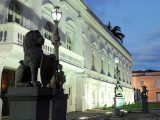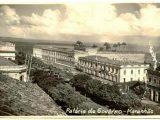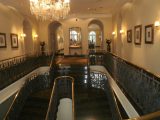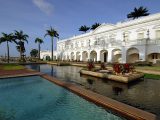Este post também está disponível em:
Português
English

The Palácio dos Leões in São Luís do Maranhão has 3,000 square metres of built area, divided into three wings: residential, administrative and visitation.
The collection of 1,300 art objects is displayed in five noble halls. There are canvases by renowned artists, crystals, Portuguese silverware, French carpets and porcelain.
One of the highlights of the collection is the engravings of the Maranhão journalist and theatrical artist Arthur Azevedo.
The Palácio dos Leões, the political and institutional headquarters of the Government of the State of Maranhão and one of the state’s greatest architectural heritage sites, historically dates back to 8 September 1612, when the French, led by Daniel de La Touche, Lord of La Ravardiere, established Equinocial France between the estuaries of the Anil and Bacanga rivers, on the island of Upaon Açu, beginning the construction of a fort, which they named São Luís, in honour of the King of France.
Video about the Palácio dos Leões in São Luís do Maranhão

Palácio dos Leões em São Luís do Maranhão
After the expulsion of the French in 1615, Captain Major Jerônimo de Albuquerque, using the labour of the Indians, began to build the governors’ residence in rammed earth on the site of Fort São Luís, named São Filipe by the Portuguese, according to a project by military engineer Francisco de Frias Mesquita.

In 1766, Governor Joaquim de Mello e Póvoas ordered the demolition of the old Government Palace and had a new headquarters built.
The building, made of stone and lime, was sober, squat, with overhanging eaves, a low roof and the entrance on the side, since it was only during the renovation undertaken in 1857 that it was moved to the centre of the building.
Throughout the empire, the Palácio dos Leões underwent several renovations.
Refurbishments of the Palácio dos Leões
In 1968, the then governor José Sarney carried out internal improvements to the building, following several other renovations.
The Palácio dos Leões was expanded with the acquisition of the building of the former National Treasury Tax Office, which was located next door, significantly increasing its administrative facilities.
In 1970, the governor Pedro Neiva de Santana complemented and finished the decoration of the Palace of Lions started in the Sarney government, recovering the pinacoteca and reforming all the decoration of the rooms and dependencies, including placing chandeliers, carpets and curtains.

During the last renovation of the Palácio dos Leões, the main facilities and the roof were restored and the registration of works of art, furniture, silverware, crockery and all other goods and objects subject to inventory began.
The Palácio dos Leões holds a rich cultural heritage
Much more than the sumptuousness of its front structure, guarded by two imposing lions representing the Executive Branch, the Palácio dos Leões has three thousand square metres of built area, divided into three wings – residential, administrative and visitation – which hold a rich cultural collection consisting of pinacoteca, sculptures, porcelain, silverware, crystals and furniture.
The five noble halls of the Palácio dos Leões hold 1,300 works of inestimable artistic value, which are now inventoried, listed and catalogued and can be admired by visitors.
Among the pieces on display are chandeliers, candlesticks, French carpets, crystal chandeliers, fine porcelain brought from countries such as China, France and Austria and Portuguese silverware.
The Palace houses eclectic furniture and exhibits pieces dating back more than 200 years. Among the pieces on display are chandeliers, candlesticks, French rugs, crystal chandeliers, fine porcelain brought from countries such as China, France and Austria and Portuguese silverware.

Rarities in the Palácio dos Leões
The collection of the Palácio dos Leões also includes rarities such as a handmade Biedermier and the Arcais (a piece of furniture used to store ecclesiastical objects), which belonged to the chapel of Bom Jesus dos Navegantes.
Another gem is the collection of fine arts by Arthur Azevedo and belonging to the House’s collection. There are oil paintings, some of them very valuable, such as those by Eliseu Visconti, Vitor Meireles and Parreiras.
If you would like to visit the monument’s halls and its pleasant gardens, the Palace opens its doors for guided tours by its curatorial team on Mondays, Wednesdays and Fridays, from 2pm to 5.30pm, and on Saturdays and Sundays, from 3pm to 5pm.
Schools can make an appointment. If you prefer, the Palácio dos Leões has a website that invites you to take a 360-degree virtual tour of its majestic surroundings. To check it out, just access the address: www.ma.gov.br/palaciodosleoes.
Palácio dos Leões – Administrative Headquarters of the Government of the State of Maranhão
Where: Av. D. Pedro II, Centre
Visitation: Tuesday to Friday, from 9am to 12pm and from 2pm to 5pm; Saturdays and Sundays, from 9am to 12pm.
Information: (98) 3232-9789
Tourism and Travel Guide of São Luís do Maranhão



















